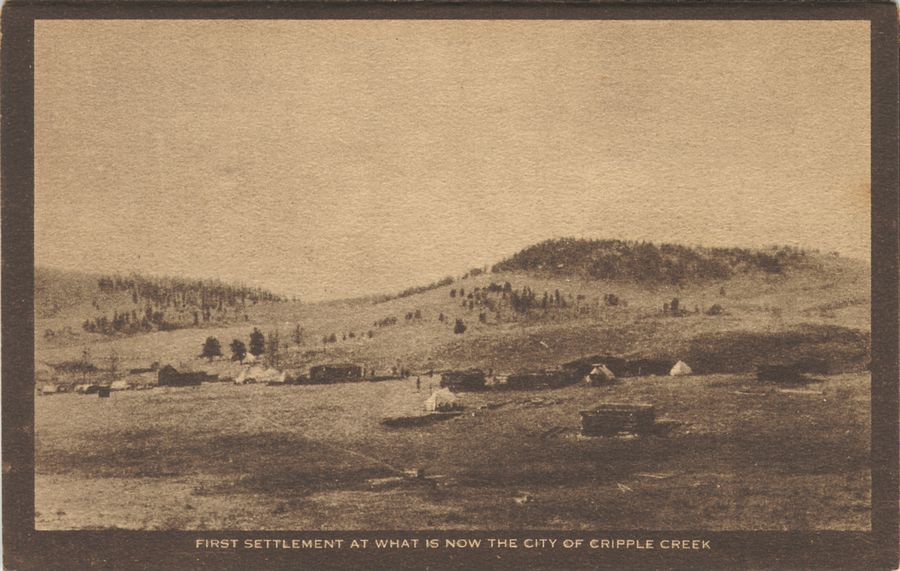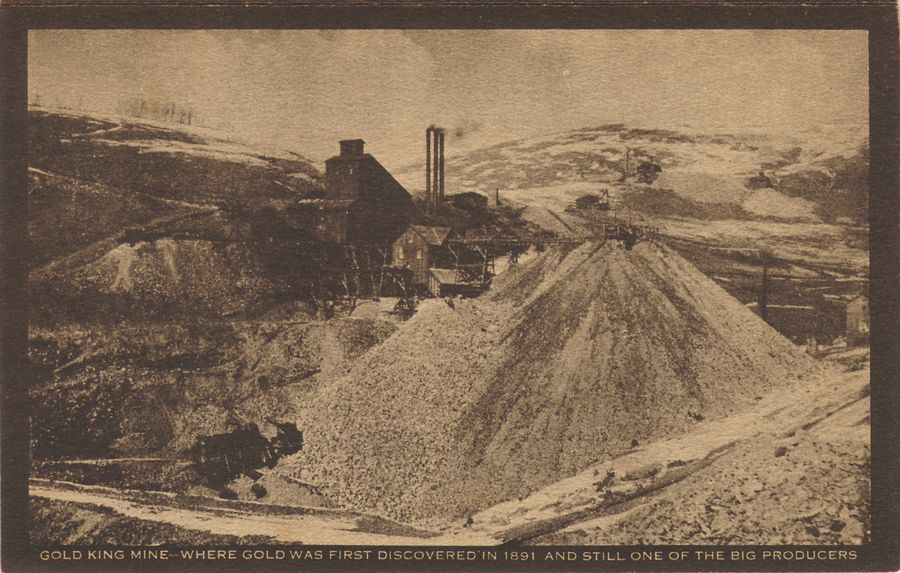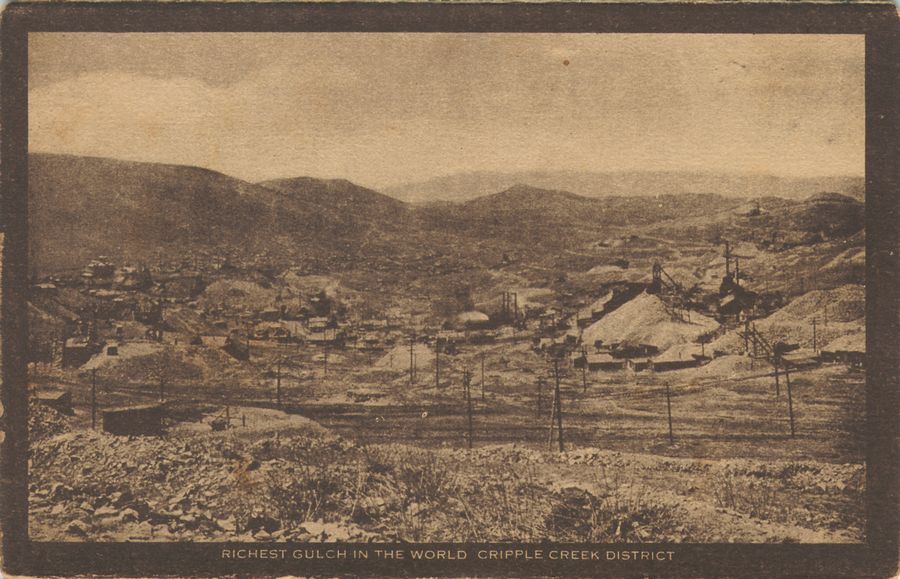-> Found at the Colorado Historic Newspaper site. Or direct to the text.
Sunday Morning, December 31, 1899.
(page 13 or numbered 9)
Source had no images, so I used some images from my collection.
| 1891 | $ 200,000.00 |
| 1892 | 600,000.00 |
| 1893 | 2,500,000.00 |
| 1894 | 4,000,000.00 |
| 1895 | 8,000,000.00 |
| 1896 | 10,000,000.00 |
| 1897 | 12,000,000.00 |
| 1898 | 16,000,000.00 |
| 1899 | 21,000,000.00 |
This, in brief, represents a decade in the mining industry which no other gold mining section has ever approximated, comprehending as it does but six miles square.
In 1887, as is well known to every one familiar with the history of this region, the country was virgin, with no indication of mineral of any kind. There had been sporadic instances where prospectors passing through the country had upturned evidences of a formation which might produce values.
This was the case in this year at a point where is now located the works of the Colorado City Reduction plant in Arequa gulch. Some old-time miners from Leadville had put up their discovery stake and sunk a shaft. The lead upon which they worked was quartz bearing, and in the white mass was seen an occasional glint of the precious metal. These miners were quartz miners who, while they had had some experience in the carbonate beds of Lake county in the good old silver days when the white metal controlled the market at from 90 cents to $1, yet retained some of their old notions with regard to quartz-bearing leads. Little they knew of the scientific processes upon which the mining industry of this district was to be eventually solved, and they knew less of the application of chemicals to the reduction of eruptive ores. All around them in the hills were vast dykes of lava, thrown up in the convulsions of nature. These dykes to them gave no indication of any mineral wealth. To them they were but vast bodies of formation, possibly suitable in large cities for the construction of buildings. They went to work upon the lead which to them seemed to give strong evidence of value. When the shaft was driven to a depth of 50 feet between granite walls, they abandoned the proposition and returned to their ranches in the vicinity of Fountain.
A year later they returned with a grub stake and prospected the hills more thoroughly for the vast leads of quartz which they confidently believed existed. Sa far as their subsequent researches are concerned nothing is known of them further than is related by Mr. Bob Womack, who stated that these gentlemen, after exhausting their grub stake, departed into the shadows of the Sangre de Christo, leaving him alone to work out the redemption of this great region.
While this desultory work was in operation, the cattle men roamed with freedom over the hills, and their herds filled the valleys. It was an ideal region, for the cattle men and its fame reached beyond the confines of the state. As public domain it was occupied by, and the cattle men had undisputed control up to the close of that decade.
In 1890 the homesteader and the preemptor came into the country from Fountain, Colorado Springs, Monument, and as far north as Denver, and soon the land in the valleys was cut into squares and began to be designated as a productive feeding country. The ranches at Arequa, the, Box ranch, Love's ranch, and scores of others we might mention, began to be widely known as feeding grounds.
About this time, Womack, Colonel Bryan, Frisbie and others began to instill into the minds of the more adventurous of Colorado Springs some of their own confidence. They had erected their cabins in the hills; they had sunk shafts and driven tunnels in various places, and the result of their labor was the frequent orders upon the assay offices at Colorado Springs. Ore in gunny sacks began to make its appearance, and the fire tests upon these were so surprising at times that frequent charges of salting were made against these pioneers.
They kept faithfully to their work, however, and by the close of the year 1890 scores of persons had come into the country and in a limited way were doing all that was possible to prove the accuracy of these tests. Gradually, companies were formed and some of the richest mines to-day still retain the fanciful names which were given to them when they were but mere holes in the sides of the hills.
In the year 1891 the new district was actually born, and as will be seen in the figures above the output for that year aggregated, $200,000. Then began the rush which, has continued uninterrupted until the present time. Cripple Creek in that year took name, and in that year were laid the foundations of the wealth which scores upon scores of men, then poor, are to-day enjoying.
The whole matter of gathering gold from grazing land was so unusual and strange that these men sent out their ore almost expecting to be ridiculed by the mill and smelter men throughout the state. One of the first loads was float, picked up by Mr. and Mrs. Frisbie from the surface near Womack's discovery shaft, and the mine subsequently became the El Paso Gold King. They hauled the ore to Florence in a road wagon and received $140 net.
The Womack discovery, which that year was named the El Paso, sent out some of the ore. The Victor, then but a mere hole in the ground, shipped an occasional load, and Stratton was making an occasional 50-pound shipment from the properties which he had located on Battle mountain. There was also some from the Buena Vista, but a greater quantity came from the placers west of town, to which the attention of the prospectors was mainly directed.
All this was desultory work, as one might suppose, but it was sufficient to prove that the predictions made by Womack and his coterie of fortune hunters from the Fountain would be realized.
It was not until a year later that actual mining upon the scientific principle had begun. Nothing below $50 per ton could be shipped with profit, as all ore had to be hauled out of the district by wagon and the way was long and rough. The ore could be taken to Divide and shipped via the Colorado Midland or it could be hauled to Canon City and loaded into D. & R. G. cars, or it could be hauled direct to the smelters at Pueblo and Denver.
All three of these methods were employed, and whichever one was chosen the expense was heavy and ate up the profits on everything except the high grade ore. The district was being staked out with great rapidity, and with the increase of population and the consequent spread of the prospectors over the hills, new discoveries were made daily, and this year the output trebled that of the previous year, and in round numbers aggregated 600,000.
In 1893 the camp's production made a marvelous jump, and the output at the close of December was $2,500,000. Without the ordinary facilities for transportation, and with hardships such as settlers in other camps had not experienced, this large increase naturally attracted wide public attention, and Cripple Creek became the object of much favorable speculation.
Ingress and egress to the camp was by stage only, and provisions had to be freighted in by teams at great expense. Notwithstanding these drawbacks, the camp grew daily, and daily its ore bearing capacity was increased by the discovery of mineral and unsuspected treasure.
Much of the increase in this year came from Bull Hill and Battle mountain. To those mines already mentioned, were added the Pharmacist and the Portland.
In the year 1894, the output was $4,000,000, and this was the year of the great labor strike. Despite this drawback, the ratio of increase continued, and this year the first railroad reached the camp, and made transportation cheaper and more expeditious. All doubt as to the permanency of the district had been removed and a second line of railroad was built as fast as men and teams could do the heavy work required.
When the labor troubles had been settled the camp came down to the basis which has never since been disturbed.
There is nothing to distinguish the year 1895 from its predecessors save a continual and steady growth which surprised even those who were most familiar with the district. A few outside experts continued to give it as their opinion that the gold deposits were all near the surface, and would be soon exhausted. Shafts on the shipping mines had reached a depth in many cases of many hundred feet, and the ore continued to increase in richness.
Despite unfavorable predictions, outside capital began to be heavily interested in Cripple Creek and development work went on at a heavily increased rate. The output for this year was $8,100,000. Most important of all the events in the now great gold camp for the year 1896 was the great conflagration which swept the town of Cripple Creek and the city of West Cripple Creek off the map. However, it was important only on the bearing on the growth and style of the city itself, not having any effect perceptible on the output of the mines.
Few of the properties except the small leased were in any way hampered by the burning and while it was being rebuilt. At the end of the year there had been sent to the smelters not less than $10,000,000 worth of the yellow metal.
It was during this year that the Abe Lincoln, the Lone Star and other mines of the Poverty gulch section were opened up. The southern limits of the camp were also extended by discoveries on Beacon hill which in another year had become one of the most prominent in the district. Both railroads were in active operation hauling ore from the camp, and hauling provisions and fuel in with great celerity and cheapness, making it possible to mine ore of a grade much lower than had ever before been possible, and making living in the camp a matter of much less expense than when everything had to be freighted over the hills.
In 1897 $1,000,000 a month was the average, or a total of $12,000.000. The chief events of the district at large were the extensions of the gold producing territory in two directions. Beacon hill on the south was brought prominently to the front by the opening up of the Orizaba and the mines on the west slope of that famous hill. Of still greater significance was the discovery on Copper mountain fully two miles north, in the Fluorine.
The chief importance in these discoveries was the bearing they had on prospecting. The recognized limits, of the gold producing belt no longer confined the efforts of the prospectors. It was seen, as the early prospectors had said, that gold is where you find it, no matter on what hill, or what formation. As a result there was an increased tendency to explore what was considered outside territory.
In the year 1898 the output had reached $10,000,000. In that year the district had extended into Grassy gulch and into the school section adjoining. To the south prospectors burrowed their way into Straub mountain, Squaw mountain was added to the list of shippers, and on every hand there were evidences that the producing area would be greatly widened. Womack hill came into the ranks. The Hull City placer began to be reckoned as a mighty force in the district's development. Copper mountain yielded its quota of the yellow metal, and in all directions there was an era of activity which added greatly to the district's prosperity.
The closing year of the 19th century opened with great promise. Improved methods and cheaper processes, previously started, branched out in full career, and the capacity of these mills began to be extended, to be extended to its utmost. During the past twelve months all these mills have increased their capacity, so that the output alone from the chemical process aggregated $1,000,000 a month. The month of December, with its $3,000,000 output is unprecedented in the camp's history.
With the increased transportation facilities which are now in process of construction, and with the advent of new mills of vast tonnage, the opening month of the new century gives promise of at least a $30,000,000 output. During the past twelve months the district has seen the introduction of electricity and its application to all the different processes of mineral development. The district has increased in population and, while it has had a set-back in one respect —that of the destruction of the business center of the thriving city of Victor, this prosperity has gone on without interruption.
In Victor, where the catastrophe of the year occurred, there has been witnessed a marvelous upbuilding, equal, if not superior, to the upbuilding of the city of Cripple Creek when it was destroyed three years previous.
In this city, where once there were mere shacks, there has arisen within the past few weeks buildings of magnitude and beauty such as no other city in the state can boast. As improvement has progressed in Victor, it has also progressed in other sections.
Goldfield has become a city of the second-class, and is widening out its municipal boundaries. Independence has grown beyond the hope of the most imaginative. Elkton, Anaconda, Gillett and Altman have enjoyed unprecedented prosperity, and the closing year witnessed the inauguration of a city which gives promise of becoming one of the most productive and influential communities in the state—the thriving city of Cameron, the seat of those vast electrical enterprises contemplated by the capitalists of Colorado Springs and Victor and the city of Cripple Creek.
The most important enterprises put in operation the current year has been the electric road, the electric power plant, and electric light enterprises, the seat of which is Goldfield. And if the year 1900 see the culmination of the vast plans contemplated by the Woods Investment company and other local capital, the district of Cripple Creek will fully justify its ambitious claim of being the chief among the world's wonders.



